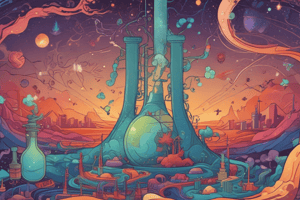Podcast
Questions and Answers
What happens to the temperature of the system when heat is evolved in a chemical reaction?
What happens to the temperature of the system when heat is evolved in a chemical reaction?
The temperature of the system rises.
Describe the change in temperature when barium hydroxide reacts with ammonium chloride.
Describe the change in temperature when barium hydroxide reacts with ammonium chloride.
The temperature of the system decreases.
What type of reaction occurs when quick lime reacts with water?
What type of reaction occurs when quick lime reacts with water?
An exothermic reaction.
What state change occurs when hydrogen chloride gas is passed over ammonia gas?
What state change occurs when hydrogen chloride gas is passed over ammonia gas?
What is the pH of a neutral substance like water?
What is the pH of a neutral substance like water?
How does the addition of sodium hydroxide affect the pH of hydrochloric acid until all HCl reacts?
How does the addition of sodium hydroxide affect the pH of hydrochloric acid until all HCl reacts?
What kind of chemical reaction involves the breaking of chemical bonds without the formation of new ones?
What kind of chemical reaction involves the breaking of chemical bonds without the formation of new ones?
What happens to the pH of an acidic solution when a base is added?
What happens to the pH of an acidic solution when a base is added?
Give an example of a reaction where the temperature of the system increases.
Give an example of a reaction where the temperature of the system increases.
What is the outcome when Ba(OH)2 reacts with 2NH4Cl?
What is the outcome when Ba(OH)2 reacts with 2NH4Cl?
Flashcards are hidden until you start studying
Study Notes
Chemical Changes and Reactions
- There are two types of changes: physical and chemical changes
- Physical changes: no new substance is formed, and the chemical composition remains the same
- Chemical changes: a permanent change in which the original substance gives rise to one or more new substances with different properties
Types of Chemical Changes
- Direct combination
- Decomposition
- Displacement
- Double decomposition
Conditions Necessary for a Chemical Change
- Close contact between reactants
- Reactants in an aqueous or molten state
- Heat
- Light
- Electricity
- Pressure
- Catalyst
Characteristics of Chemical Reactions
- Change in colour
- Formation of a precipitate
- Evolution of a gas
- Change in temperature
- Change of state
- Change in pH
Energy Changes in a Chemical Change
- Exothermic reactions: heat is evolved, and the temperature of the system rises
- Endothermic reactions: heat is absorbed, and the temperature of the system decreases
Examples of Chemical Changes
- Rusting of iron on exposure to moist air
- Burning of wood to give gases and ash
- Curdling of milk when left at room temperature during summer
- Ripening of fruits
- Cooking of food
- Iron dipped in a solution of copper sulphate
- Magnesium ribbon heated to produce magnesium oxide
- Sodium metal reacting with distilled water to produce sodium hydroxide solution and liberating hydrogen gas
Studying That Suits You
Use AI to generate personalized quizzes and flashcards to suit your learning preferences.




